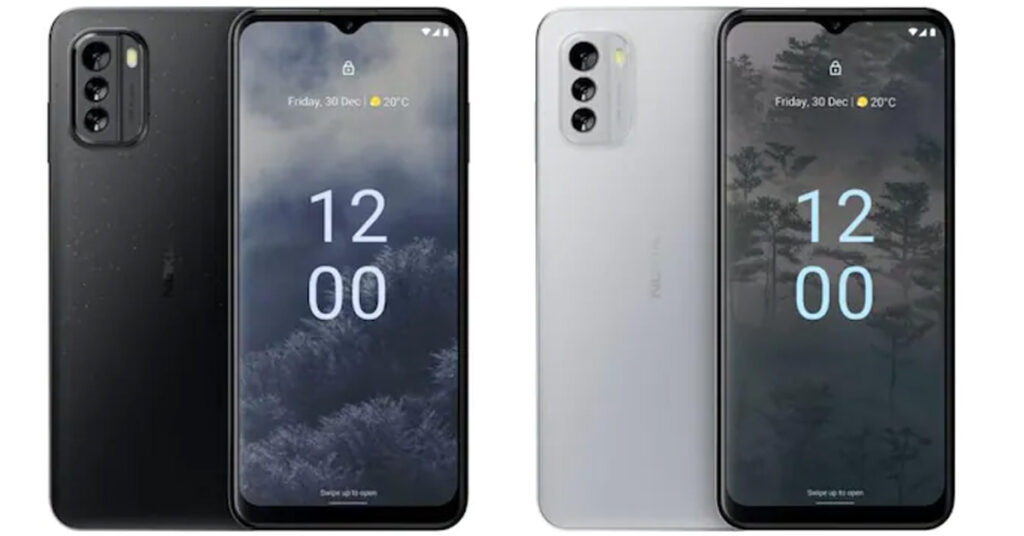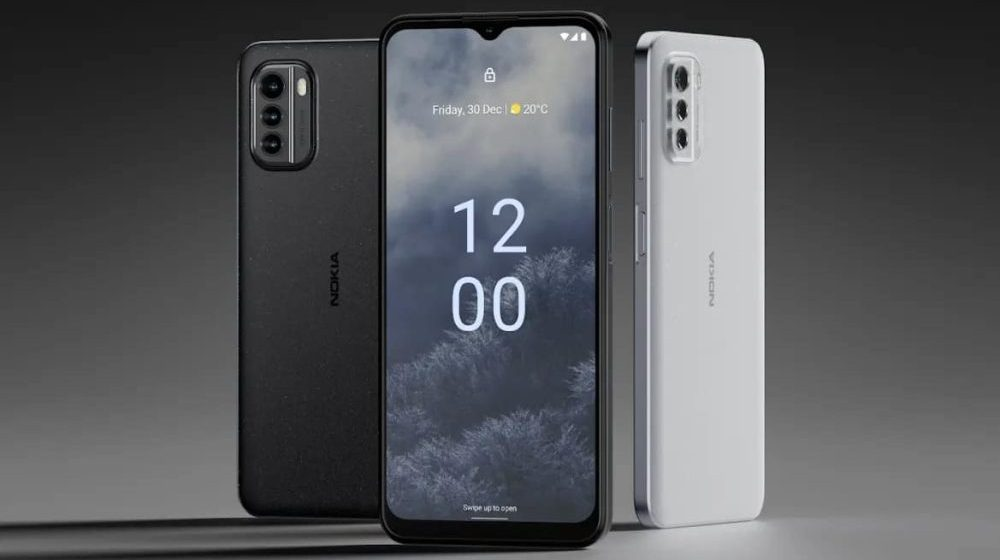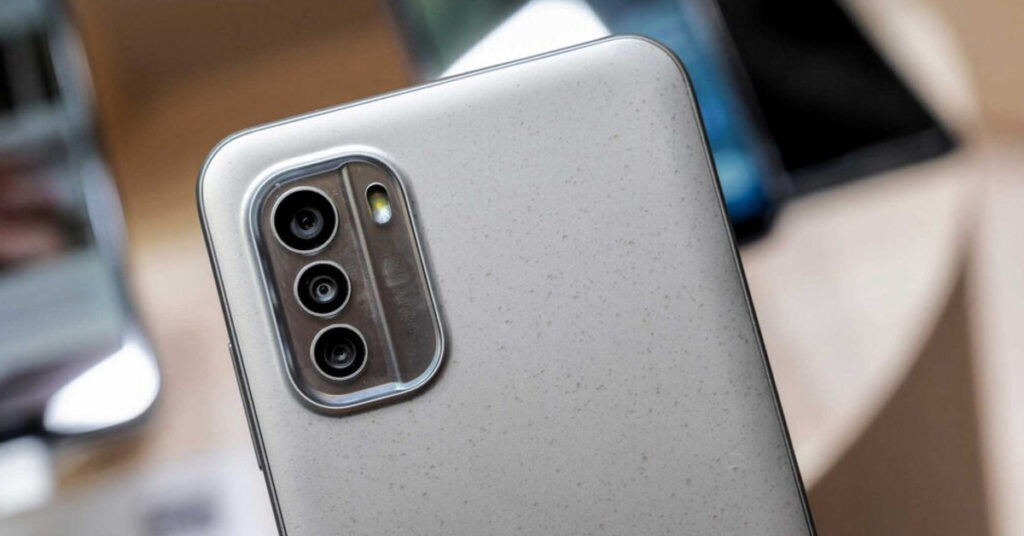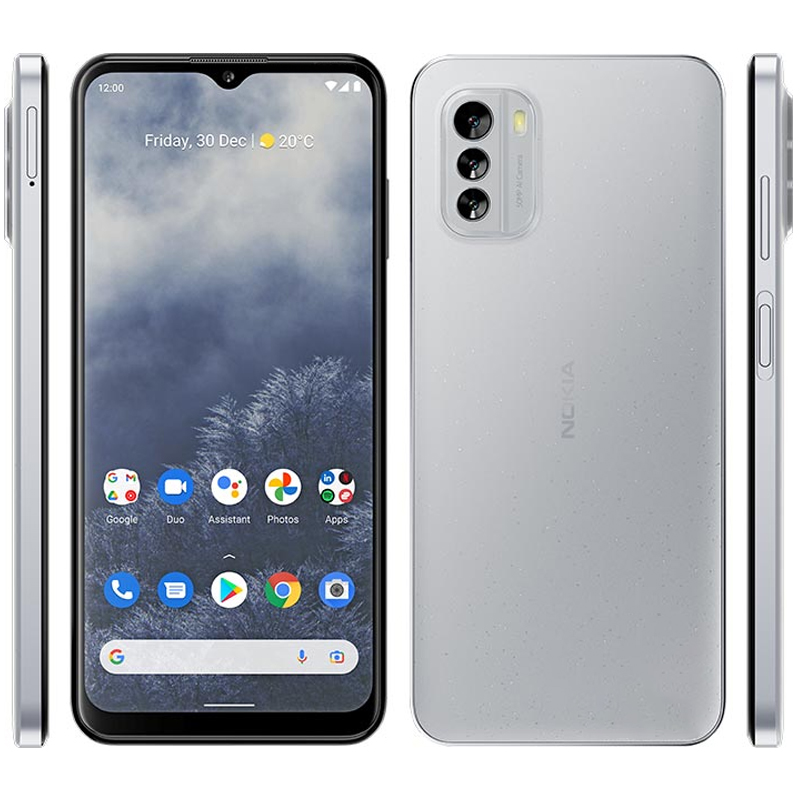Nokia’s G60 5G smartphone is made with 60% recycled plastic so it lasts longer. By keeping a circular phone, you’ll get ‘seeds’, virtual rewards Nokia donates to charitable causes. You’re helping clean up rivers, regrowth forests, and save money. With the Nokia Phone’s 3 years of warranty, OS upgrades, and monthly security updates, the mid-range phone looks sustainable, but does it live up to expectations?

Nokia G60 Main Highlights:
The Nokia G60 5G phone has a 6.58-inch screen. This is quite a large screen, especially for the size of your pocket and hands. It has a screen size of 5.5 to 6.2 inches, which is a convenient size for your pocket and hands. However, different people have different needs. The G60 phone’s screen-to-body ratio is 82.8% with dimensions of 6.54 x 2.99 x 0.34 inches. The Nokia G60 phone is made up of 60% recycled plastic, though it weighs just over 190 g (6.70 oz) and the back and frame are made from plastic, but thanks to the Nokia Gorilla Glass 5, the front of the phone is made of glass.
Even though Nokia does not use AMOLED screens, the G60’s IPS LCD screen isn’t terrible, with Full HD 1440 x 2560 pixels a 20:9 aspect ratio, and 401 pixels-per-inch density. It’s not sharp and crisp when you watch YouTube and Netflix ultra HD movies because some of the details are missing and the colors are dull. The Nokia G60 smartphone has a maximum brightness of just 400 nits, so it’s a problem when using it outdoors.
However, Nokia G60 mobile phones can’t withstand much water. For example, if you’re trying to wash your hands or cook, Favor is splash-proof, so you can wear it, wash your hands, and walk in the rain without getting water-damaged. You can insert one SIM card (Nano-SIM or eSIM) or a hybrid dual SIM card (Nano-SIM, dual standby).

Nokia G60 Performance & Storage:
With its hardware specifications, the Nokia G60 is an interesting smartphone. The Qualcomm SM6375 Snapdragon 695 5G chipset is very popular in the mid-range. The power is usually sufficient for smooth system operation in everyday use. Only more complex apps cause stutters. In addition to the Adreno 619 graphics processor, the Nokia G60 smartphone has two Kryo 660 Gold cores running at 2.2GHz and six Kryo 660 Silver cores running at 1.7GHz. The processor is designed to provide a better gaming and multimedia experience. With its 6nm process, this phone is capable of achieving high battery efficiency, enhancing images as a result.
There’s the same Qualcomm SM6375 Snapdragon 695 5G chip as in the Vivo brand Vivo Y16 smartphone. However, the software, storage, and RAM on this phone are different. Therefore, this phone might act differently than the Nokia phone.
As soon as you open the Nokia G60 5G, the smartphone you’ll see Android 12. This version brought massive visual changes to Android, so the Android OS has become gorgeous. While it’s a shame this phone didn’t come with Android 13, Nokia’s phone guarantee of 3 years of software updates makes it less sour in the mouth.
Nokia G60 mobile phone keeps Android 12 as simple as possible, so it’s no surprise it runs so well. When you tap on text boxes, you don’t have to wait around for the keyboard to show up. It wakes quickly from sleep, scrolls through home screens with minimal fuss, and doesn’t leave you waiting around. There’s a half-second wait when switching between the main and ultrawide cameras, and more demanding apps take a few seconds longer to open than they might on a more powerful midrange phone, but it’s perfectly serviceable as a daily driver.
Nokia G60 smartphones have three types of storage: 64GB and 128GB with 4GB of RAM, and 128GB with 6GB of RAM. The Nokia G60 phone runs on Android 12. You can customize the interface to your liking with its many custom features. Overall, the user experience looks appealing with its fresh and unique features. They both have microSD slots, so you can expand their capacity whenever you want.
Nokia G60 Camera Specs:
This Nokia G60 smartphone has an awesome 50MP (wide) main camera. It has a 50MP sensor, f/1.8 aperture, 1/2.5″, 0.7µm and phase detection autofocus (PDAF). There’s also a 5MP, f/2.2, (ultrawide), and a 2MP, f/2.4, (depth) with LED flash, HDR, and panorama. The Nokia G60 also has a rear camera that shoots 1080p full HD at 30 frames per second.
The main sensor Nokia G60 Phone can still handle the job in daylight conditions, preserving details and balancing highlights and shadows well. There isn’t much difference between the primary camera and the ultrawide camera in reasonable light. Fine details aren’t quite well defined, but the color is consistent and exposure is pretty acceptable. As a result of Nokia’s newly introduced Capture Fusion mode, a cropped shot of the main sensor gets used for the central part of any ultrawide image – which leaves the actual ultrawide sensor filling in the gaps around it.
It’s the same 50 MP camera as the Honor X40 and Motorola G60, mobile phones but the quality and specs are different. Mobile phones with triple cameras don’t give the same results since there are different rear-facing cameras on each one. While Motorola’s 50MP camera has OIS (Optical Image Stabilization), Nokia hasn’t adopted the Motorola G60 because it is so expensive compared to the Nokia G60, so you can enjoy the camera even on a low budget.
The Nokia G60 phone’s front-facing 8MP camera produces clear pictures with its f/2.0 aperture, 1/4.0″, 1.12µm micrometer pixels. While HDR mode helps, the 8MP selfie camera up front doesn’t quite manage to balance light and shadow. Even though overall detail won’t blow you away, the results are cleaner than the competition that uses quad-binned snappers with high pixel counts.

Nokia G60 Battery Power:
There’s a 4500mAh battery on the Nokia G60 smartphone and a 20W fast charger. Competitors with similar prices have 5000mAh batteries. Because of the small battery size, the G60 phone has to make concessions in terms of runtimes: 14:31 hours is still a decent runtime, and with moderate use, you can even go two days without a power outlet. It takes about 2 hours to fully charge the empty 4,500mAh battery.
Depending on how intensively you use it, the Nokia G60 phone can die in six hours if you use it too much. I wish HMD Global had equipped it with 30W fast charging. Instead, it got 20W. It isn’t terrible, but… While it’s not super fast, it gets us a 50% charge in about 30 minutes. I’d love 30W or 33W fast charging, at the very least.
A budget phone doesn’t come with wireless charging, which isn’t surprising, and Nokia phones don’t include a power brick either, as part of its effort to reduce e-waste. You should be able to charge it with any adapter you have lying around because it’s capable of 20W charging over USB-C.
Nokia G60 Connectivity & Other Specs:
WLAN:
Higher bandwidth with Nokia’s Wi-Fi 6 means faster uploads and downloads. The highest throughput of Wi-Fi 6 over multiple channels is 9.6 Gbps, while Wi-Fi 5 offers 3.5 Gbps. These are theoretical maximums, however, in actuality, local networks may not achieve these speeds. Due to the fact that the maximum speed is shared by multiple devices even if they do not reach it, Wi-Fi 6 devices are still capable of significantly faster speeds even if they do not reach the maximum speed.
Dual-band and hotspot options are also available on the Nokia G60 smartphone. In the context of mobile phone networks, a dual-band device allows mobile devices to operate on two different frequencies. A Nokia G60 phone hotspot lets you connect to your WiFi network while you’re away from home or the office.
Bluetooth & sound:
The Nokia G60 smartphone bottom edge speaker cannot get that loud, and sounds quite thin during music and speech – this phone doesn’t have stereo speakers. Better sound is provided by external devices that can be connected via Bluetooth or a 3.5 mm port. Modern aptX codecs like aptX Adaptive and aptX HD are supported through Bluetooth, so you can hear better sound and music.
GPS:
The Nokia G60 smartphone GPS system is equipped with A-GPS, GALILEO, and BDS systems. GPS is maintained by the United States government and is freely accessible to anyone with a GPS receiver. As part of the Galileo global navigation satellite system (GNSS), the European Union launched it through the European Space Agency (ESA) and it is operated by EUSPA, based in Prague, Czech Republic. Known as the Big Dipper in Chinese, BeiDou (Big Dipper) BDS is the constellation’s name.
NFC
NFC technology is used by Nokia G60 mobile phones for easy payments, and it’s the same technology used by contactless credit cards. In addition to connecting wireless devices and transferring data, NFC can also be paired with Android Beam to transfer data quickly. However, this option is not available in all markets or regions.
Network:
Mobile network technologies supported by the Nokia G60 smartphone include GSM, HSPA, LTE, and 5G.
It stands for Global System for Mobile Communication (GSM), High-Speed Packet Access (HSPA), Long Term Evolution (LTE), and 5G (the fifth generation of cellular communications).
This mobile phone has 2G bands GSM 850 / 900 / 1800 / 1900 – SIM 1 & SIM 2 (dual-SIM model only)
Nokia G60 mobile phone 3G bands available HSDPA 850 / 900 / 1900 / 2100 – International
HSDPA 850 / 900 / 1700(AWS) / 1900 / 2100 – LATAM
4G bands for this mobile phone are 1, 3, 5, 7, 8, 20, 28, 38, 39, 40, 41 – International
1, 2, 3, 4, 5, 7, 8, 12, 17, 13, 20, 28, 38, 39, 40, 41, 66 – LATAM
5G bands for Nokia G60 smartphones include 1, 3, 5, 7, 28, 38, 40, 41, 77, 78 SA/NSA/Sub6 – International
1, 3, 5, 7, 28, 38, 40, 41, 66, 78 SA/NSA/Sub6 – LATAM
A comparison of Nokia G60 mobile phone speeds on different networks, including HSPA 42.2/5.76 Mbps, LTE, 5G
Other:
Even though the Nokia G60 smartphone is popular, some prefer to listen to radio news and a variety of channels, or radio signals are more convenient when traveling. Nokia G60 smartphones use USB Type-C 2.1, with USB On-The-Go (USB OTG) support. USB Type-C 2.1 supports up to a maximum of 40 GB/s (4.8 GB/s). A speed of 40 Gb/s for USB-C type 2.1 is equivalent to 1.5 hours of 4K video being transferred in 2 seconds. In terms of Nokia G60 sensors, there are accelerometers, gyroscopes, proximity sensors, and compass sensors. In the Nokia G60, the fingerprint sensor is located on the side (side-mounted).
Nokia G60 Price & Availability:
All things considered, the Nokia G60 smartphone is a reliable phone that will not cause a lot of frustration for its eventual owners. Does it still deserve to be purchased at its original price of €350, though? In our opinion, the HMD phone simply cannot compete with Samsung, Redmi, OnePlus, Oppo, and Motorola at that price point.


Thanks for your publication on this blog. From my experience, occasionally softening right up a photograph may well provide the digital photographer with an amount of an imaginative flare. More often than not however, the soft clouds isn’t just what exactly you had at heart and can usually spoil an otherwise good snapshot, especially if you intend on enlarging that.
The free Cam to Cam starting credit is worth it! With this gift you can convince yourself of the quality of the free show room and have a look around without obligation.